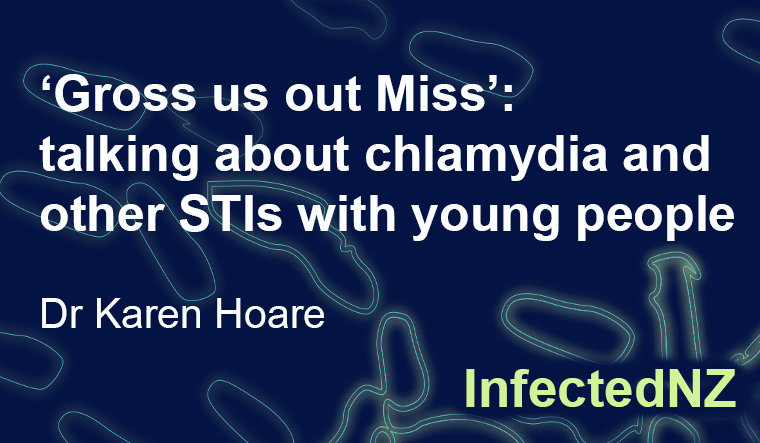Chlamydia is not a very sexy topic… it should be though, because it’s caught by having sex. It’s surprising how many young people don’t know how common chlamydia is. It’s easy to treat but it’s so much easier to prevent by using condoms when having oral, anal, or vaginal sex.
I’m a Nurse Practitioner for children and young people and also a Senior Lecturer at the University of Auckland. I work in a general practice clinic where we also provide health services for young people by going into three high schools.
Recently I’ve been asking young people about the best way to get information about STIs out to their age group. Chlamydia is a big problem for young people in New Zealand. In 2013 we tested 246 people between 15 and 18 years old who were seeking sexual health care for chlamydia. We found that 36% were positive. What people don’t realise is that chlamydia rarely causes any unpleasant symptoms, but it can have a lifelong consequence of infertility. So when you want to have a baby you can’t because your tubes (both male and female) are clogged up from past chlamydia infections.
Chlamydia is most commonly found in young people aged 15 – 29 years. Young women have higher rates than young men, but that may be due to women getting tested more frequently.  What is most concerning is that young Māori women have rates 2-3 times higher than NZ Europeans.
What is most concerning is that young Māori women have rates 2-3 times higher than NZ Europeans.
“Social media like on Facebook, Instagram, Twitter and stuff” would be the best way to spread the word, said one group of 16 – 18 year old girls I asked (amidst chatter about whether you could get pregnant if you were the girl on top).
“You should start a movement or like have a campaign,” was another suggestion. They also said that they should be more educated about it and that it should be compulsory for Years 9 to 13. “They do it in intermediate [learn about sexual health] but that’s when they’re like really immature and they don’t listen.”
When asked what would help them learn about STIs, the girls thought that they should be “grossed out as much as you can” by showing them horrible pictures of infections and by getting testimonials from people who’ve had an STI. Scare tactics work, they said, because people don’t believe it will happen to them. “Come to the schools and talk to us in assemblies and put posters up with pictures, not heaps and heaps of words,” were a couple of suggestions. “Get on to Facebook to start a campaign like #saynotochlamydia or #chlamydiaisnotourfuture.”
“Could you handle being grossed out by pictures [of STIs]?” I asked a group of 16 – 18 year old boys. “Yeah, if they see pictures and realise they may have it, they’d wanna get a check up.” There was a suggestion that it could be featured in Shortland Street, depicting ordinary people getting an STI. “You should get someone who’s had chlamydia to talk about it,” said one boy. In this group we then went on to talk about the symptoms you might get if you had an STI, closely followed by the different sizes, shapes, colours and flavours of condoms that a boy called Kevin [pseudonym] had.
As a country we ratified a Treaty called the United Nations Convention on the Rights of the Child (UNCRC) back in 1993. Article 12 of the UNCRC states that children have the right to an opinion in all matters that affect them. As we know that chlamydia predominantly infects children and young people, they should have a say in how they are taught about the issue. My sessions with young people talking about STIs both individually and in groups have always been informative and very helpful from a health professional perspective. I often quote the saying from Phillip McMillan Bowse who was a contributor to England’s Eden project: “If you want to achieve the impossible – give it to the young, because they don’t know it can’t be done.”
About
Dr Karen Hoare is a Nurse Practitioner for children and young people and also a Senior Lecturer at the University of Auckland.
What is InfectedNZ?
Hey, Aotearoa. It’s time we had a chat about infectious diseases and what we’re going to do about the looming antimicrobial armageddon. That’s why we’ve asked leading health, social and economic researchers, and people with personal stories, to help us get real about our vulnerability and discuss solutions. Follow their blogs right here at tepunhahamatatini.ac.nz and watch the conversation spread across social media with #infectedNZ.
Backing it all up, wherever possible, is data from the good folk at Figure.NZ. Their super duper charts are based on data sourced from public repositories, government departments, academics and corporations. Check out their #infectedNZ data board and sign-up to create your very own data board on any topic that floats your boat.

